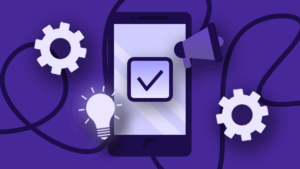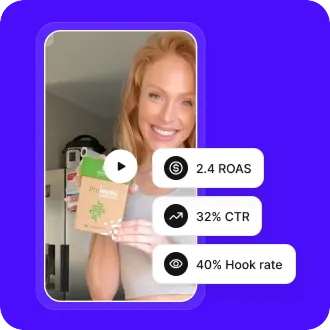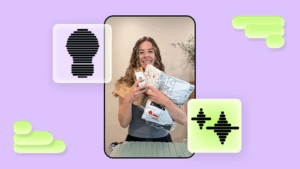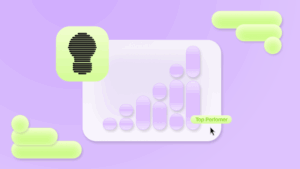Ad Testing For Social: Find Winning Creators, Hooks & Angles
I lead the paid marketing team at Billo, focusing on performance, testing, and growth that scales.Over the past 6 years, I’ve worked across digital marketing - from running campaigns to building the strategies and systems behind them.What drives me is problem-solving. I like turning complex questions into simple, testable answers, and making decisions that actually drive impact.

Good ads make the biggest difference on social media, so you need proof, not just guesses. Studies from Nielsen/NCS show that creative quality is the number one factor driving sales. Today’s platforms, like Meta, TikTok, and YouTube, let you run tests to learn quickly.
This playbook will show you how to test ads to find the best creators, hooks, and ideas. You’ll also learn how to set up fair experiments, measure what really works, and scale up winning ads without wearing them out. We’ll keep it practical and platform-native so your ad testing translates to lower CPA and higher ROAS, not just prettier dashboards.
TL;DR:
- Treat ad testing as an ongoing process: hypothesize → test one variable → measure → scale.
- Focus on three high-impact levers: creators, hooks, and angles.
- Track CPA/ROAS first, but use attention metrics (thumb-stop, watch rates) for faster feedback loops.
- Use platform-native tools (Meta A/B Testing, TikTok Split Testing) to ensure randomized, unbiased experiments.
- Avoid pitfalls like overlapping audiences, peeking early, and letting fatigue erode performance.
- Validate with incrementality tests (Meta Conversion Lift, TikTok Brand Lift) to prove true business impact.
What is Ad Testing?
Ad testing is the practice of running controlled, randomized experiments on your ads to learn what causes better performance. Allowing you to scale with confidence.
In digital, A/B and multivariate tests establish causality when assignments and audiences are properly controlled, a foundation explained in Kohavi’s survey of online experiments. On social platforms, you can use built-in experimentation tools to split comparable, non-overlapping audiences and avoid delivery bias with tools like Meta’s A/B Testing and TikTok’s Split Testing.
A/B vs. MVT
When testing ads, it’s best to use A/B tests that change only one thing at a time, like the creator, the hook, or the angle, so the results are clear. You can test many things at once, but that takes a lot more money and a bigger audience.
Both Meta and TikTok make it easy to set up separate groups and pick a winner using their own rules for confidence.
Validity basics you can’t skip
- Randomize fairly and keep audiences non-overlapping in every test.
- Before you spend a dollar, pre-compute sample size and minimum detectable effect using Evan Miller’s sample size calculator.
- Set stop rules up front; avoid “peeking” mid-test, which inflates false positives, as outlined in How Not to Run an A/B Test.
- While testing ad variations, change one variable at a time and let the test run to significance.
Nail these fundamentals, and ad testing turns creative choices into confident, scalable decisions.
Why Ad Testing Is Critical for Social Ads
On social platforms, attention is scarce, and creative is the biggest lever you control. Research from Nielsen and NCS shows that creative quality accounts for the largest share of sales lift, even more than media targeting or reach. That makes structured ad testing essential: it helps you identify which creators, ad hooks, and angles truly drive outcomes instead of relying on guesswork.
Without experimentation, you risk wasting spend on unproven concepts or over-indexing on surface metrics like CTR. By running proper ad testing workflows, you can validate incrementality, understand which creative elements move the needle, and double down on winners before ad fatigue sets in.
In short: ad budgets are too valuable to gamble on hunches. Systematic ad testing ensures your creative decisions compound into lower CPA and higher ROAS over time.
How To Test Ads Effectively (Framework + Platforms)
Effective ad testing follows a repeatable framework: hypothesize, test, measure, and scale. By approaching creative experimentation systematically, you avoid chasing vanity metrics and instead build a compounding learning loop.
1. Hypothesize Clearly
Every test starts with a sharp question: Which creator drives better engagement? Does a direct hook outperform a curiosity angle?
Defining the hypothesis upfront keeps tests focused and results actionable.
2. Test One Variable at a Time
In creative ad testing, isolate variables – creator, hook, or angle, for clean comparisons. Use platform-native tools such as Meta’s A/B Testing and TikTok Split Testing to ensure randomization and non-overlapping audiences. Running multiple changes at once muddies insights and wastes budget.
3. Measure With Discipline
Set sample sizes and minimum detectable effects in advance using tools like Evan Miller’s calculator. Resist “peeking” mid-test – ending early can inflate false positives, as explained in How Not to Run an A/B Test. Instead, let tests run their course to statistical significance.
4. Scale Winners, Refresh Losers
Once a winner is clear, shift spend confidently and feed insights back into your creative pipeline. Equally important, watch for fatigue: a high-performing ad today will degrade tomorrow without ongoing testing and iteration.
This structured approach ensures that ad testing delivers more than data points, it builds a repeatable growth engine for paid social.
What To Test: Creators, Hooks, Angles
Not all creative elements are equal. In social advertising, three levers consistently make or break performance: creators, hooks, and angles. Testing each systematically helps you identify what resonates and why.
- Creators. The messenger matters as much as the message. Testing different creators – whether influencers, customers, or actors, reveals whose delivery style and persona drive stronger engagement and conversions. A creator’s authenticity and credibility often determine whether viewers stop scrolling or swipe past.
- Hooks. The first 3 – 5 seconds decide if someone watches or bounces. Testing hooks (opening lines, visuals, or sounds) shows you which grabs attention fastest. A clear value proposition might win in one audience, while a curiosity-driven opener outperforms elsewhere. Consistently iterating hooks ensures your ads survive in crowded feeds.
- Angles. Angles are the underlying persuasion frames: problem/solution, social proof, lifestyle aspiration, or product demo. By running structured ad testing on angles, you uncover which narrative drives the best response with your audience. For example, an angle rooted in customer testimonials may beat one highlighting technical specs, even if both feature the same product.
Together, creators, hooks, and angles form the building blocks of high-performing social ads. Testing across all three levers prevents tunnel vision and helps you scale what truly converts, not just what looks good.

Find the Right Creators for Your Brand
Measuring Success (Metrics + Incrementality)
Winning in ad testing isn’t about the loudest CTR or cheapest CPC. You have to focus on the true business impact. That means aligning on the right metrics and validating incrementality.
1. Core Performance Metrics
Track bottom-line outcomes first: CPA (cost per acquisition) and ROAS (return on ad spend). While secondary signals like CTR, CPM, or watch time can guide creative iteration, they shouldn’t be mistaken for final success. The goal is always efficient conversions, not just clicks.
2. Attention and Engagement Signals
In social ads, watch rates, thumb-stop ratios, and early drop-offs help diagnose why one creative outperforms another. A hook with a high view-through rate indicates stopping power, even if purchases take more touches. These metrics make creative feedback loops faster.
3. Validate With Incrementality
True lift comes from knowing whether conversions would have happened without the ad. Platform-native tools like Meta’s Conversion Lift and TikTok’s Brand Lift let you measure incrementality with randomized control groups. This ensures your “winner” isn’t just harvesting organic demand, but actually driving net-new growth.
Get Ad Testing Wins With Billo IQ
If you want the gains of ad testing without starting from a blank page, Billo IQ gives you data-driven suggestions you can plug straight into your workflow. The native Brief Builder converts any product link into four data-backed briefs – each optimized for ROAS, CTR, Hook Rate, or a balanced mix. And then automatically pairs them with best-fit creators, so your first hypotheses are already aligned to what’s working in the market.

Here’s a simple way to turn IQ insights into results:
- Paste your product URL → get four briefs. IQ analyzes your page (selling points, imagery, social proof) and returns concepts ready to test, each with the intended performance outcome built in.
- Pick your variable. Treat each brief as a clean hypothesis (creator, hook, or angle). Launch A/Bs that change just one thing at a time (creator match included) so you keep your ad testing valid.
- Use creator matches as your “best available” control. Each brief is paired with vetted creators (5,000+ on the network) who excel at the exact metric you care about, so your test reads are faster and clearer.
- Iterate on wins. After a campaign run, use the next IQ suggestions to refine hooks, CTAs, or visuals and spin fresh variations before fatigue sets in.
- Move from idea to launch in minutes. The in-product flow is straightforward: drop a link, review the four concepts, and invite the matched creators with one click.
Under the hood, IQ is trained on hundreds of thousands of active ads and roughly a quarter-billion dollars in ad spend, so every recommendation – brief direction, creator pairing, and next iteration leans on what’s winning now, not guesswork. That’s how you capture the benefits of ad testing (clean hypotheses, sharper reads, faster refresh) without the heavy lift upfront.
Ad Testing Summary
Creative success isn’t luck; it’s a system. Run ad testing in tight loops, test the levers that matter (creators, hooks, angles), measure real lift, and refresh on a cadence.
If you want a head start on what to test next, try Billo IQ, it analyzes a wide scope of social ads and turns those patterns into ready-to-run briefs, best-fit creator matches, and smart iteration ideas based on what’s working right now. You get cleaner hypotheses, faster reads, and fresher variations without the heavy lift.
👉 Ready to put this into practice? Paste your product URL into Billo IQ, pick a data-backed brief, launch an A/B with platform experiments, and scale the winner.
Paid Marketing Lead
I lead the paid marketing team at Billo, focusing on performance, testing, and growth that scales.Over the past 6 years, I’ve worked across digital marketing - from running campaigns to building the strategies and systems behind them.What drives me is problem-solving. I like turning complex questions into simple, testable answers, and making decisions that actually drive impact.

Authentic creator videos, powered by real performance data
22,000+ brands use Billo to turn UGC into high-ROAS video ads.
Testing Ad Variations: How to Consistently Lift ...
Most performance gains come from better creative, not targeting tweaks. [...]...
Read full articleAI‑Driven Creative Coaching: How Machine Learn...
Creative is no longer just a variable – it’s the [...]...
Read full articleFrom Brief to Breakthrough: Translating Data Ins...
Marketing performance rises and falls on creative quality, but most [...]...
Read full article



